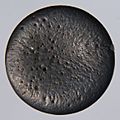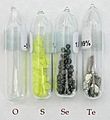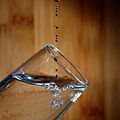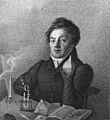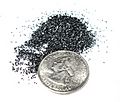Group 16 element facts for kids
Group 16 is a special family of elements in the periodic table. This group is also known as the oxygen family or the chalcogens. The elements in this group are oxygen, sulfur, selenium, tellurium, polonium, and livermorium. Oxygen, sulfur, and selenium are nonmetals, meaning they don't conduct heat or electricity well. Tellurium is a semimetal, which means it has properties of both metals and nonmetals. Polonium and livermorium are radioactive, meaning they give off energy as they break down. Oxygen, which we breathe, is a colorless gas.
| Periodic table | |||||||||||||||||||||||||||||||||||||||||
|---|---|---|---|---|---|---|---|---|---|---|---|---|---|---|---|---|---|---|---|---|---|---|---|---|---|---|---|---|---|---|---|---|---|---|---|---|---|---|---|---|---|
| H | He | ||||||||||||||||||||||||||||||||||||||||
| Li | Be | B | C | N | O | F | Ne | ||||||||||||||||||||||||||||||||||
| Na | Mg | Al | Si | P | S | Cl | Ar | ||||||||||||||||||||||||||||||||||
| K | Ca | Sc | Ti | V | Cr | Mn | Fe | Co | Ni | Cu | Zn | Ga | Ge | As | Se | Br | Kr | ||||||||||||||||||||||||
| Rb | Sr | Y | Zr | Nb | Mo | Tc | Ru | Rh | Pd | Ag | Cd | In | Sn | Sb | Te | I | Xe | ||||||||||||||||||||||||
| Cs | Ba | La | Ce | Pr | Nd | Pm | Sm | Eu | Gd | Tb | Dy | Ho | Er | Tm | Yb | Lu | Hf | Ta | W | Re | Os | Ir | Pt | Au | Hg | Tl | Pb | Bi | Po | At | Rn | ||||||||||
| Fr | Ra | Ac | Th | Pa | U | Np | Pu | Am | Cm | Bk | Cf | Es | Fm | Md | No | Lr | Rf | Db | Sg | Bh | Hs | Mt | Ds | Rg | Cn | Uut | Fl | Uup | Lv | Uus | Uuo | ||||||||||
|
|||||||||||||||||||||||||||||||||||||||||
Contents
What are Chalcogens?
The word "chalcogen" comes from Greek words meaning "ore-forming." Many of these elements are found in ores, which are rocks containing valuable minerals. This group is important because its elements have similar chemical properties. They often react in similar ways with other elements.
Meet the Elements of Group 16
There are six elements in the chalcogen family. Each one has unique features. Let's learn about them!
Oxygen: The Breath of Life
Oxygen is the first element in Group 16. It is a gas that has no color or smell. Oxygen is super important for life on Earth. We breathe oxygen to live! It makes up about 21% of the air around us. Oxygen also helps things burn. It is a key part of water (H2O) and many other compounds.
Sulfur: The Yellow Element
Sulfur is a bright yellow solid at room temperature. It has a distinct smell, often like rotten eggs, especially when it forms certain compounds. Sulfur is found in many places, including volcanoes and hot springs. It's used to make sulfuric acid, which is a very important chemical in industries. Sulfur is also found in some medicines and in gunpowder.
Selenium: The Light-Sensitive Element
Selenium is a dark gray solid. It's special because it can conduct electricity better when light shines on it. This makes selenium useful in things like solar cells and light sensors. It is also found in small amounts in our bodies and in some foods.
Tellurium: The Rare Semimetal
Tellurium is a silvery-white element. It is quite rare to find. Like selenium, tellurium is a semimetal. This means it can sometimes act like a metal and sometimes like a nonmetal. Tellurium is used in some alloys (mixtures of metals) to make them stronger. It's also used in electronics.
Polonium: The Radioactive Chalcogen
Polonium is a very rare and highly radioactive element. It was discovered by Marie Curie and Pierre Curie. Because it is so radioactive, polonium is very dangerous. It gives off a lot of heat and is used in some specialized scientific equipment.
Livermorium: The Super Heavy Element
Livermorium is a synthetic element, meaning it's made by scientists and doesn't occur naturally. It is extremely radioactive and only exists for a very short time. Scientists study elements like livermorium to understand more about the periodic table and the limits of matter.
How Chalcogens Are Used
Chalcogens are used in many different ways. Oxygen is vital for breathing and burning. Sulfur is used in fertilizers, chemicals, and even some medicines. Selenium is important in electronics and for our health. Tellurium is used in alloys and solar panels. Even the rare and radioactive ones like polonium have special uses in science.
Images for kids
-
Water (H2O) is a very common compound containing oxygen.
-
Dmitri Mendeleev's early periodic table from 1871, showing oxygen, sulfur, selenium, and tellurium in his Group VI.
-
Johann Wolfgang Döbereiner was one of the first scientists to notice similarities between these elements.
-
Gunpowder, which contains sulfur, used for fireworks and other things.
See also
 In Spanish: Anfígeno para niños
In Spanish: Anfígeno para niños




